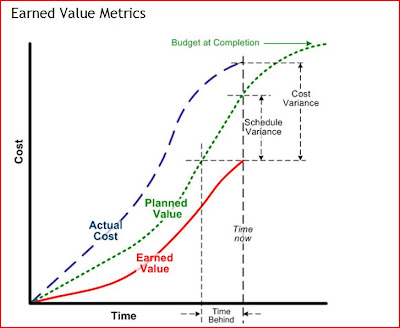W2_ASIBELI UGBOMA_EARNED VALUE ANALYSIS IN MY PROJECT TEAM
Problem recognition, definition and evaluation
My company has Earned Value Management included in our Project Controls but we are not fully utiliizing the implementation because our Cost and schedule are not aligned. Due to that even though the report is generated monthly it is not accurate.
Earned Value Management (EVM) is a Project Management technique used for measuring Project Progress in an Objective Manner. EVM has the ability to combine measurements of:
· Scope (Achieved / accomplishment of Planned work
· Schedule (behind / ahead of schedule
· Cost (under / over budget)
When properly applied EVM provides an early warning of performance problems. Additionally EVM promises to improve the definition of Project scope, communicate objective progress to stakeholders and keep the Project team focused on achieving Progress
Development of the feasible alternative
Early EVM research showed that the areas of planning and Control are significantly impacted by its use and using the methodology improves both scope definition as well as the analysis of overall Project Performance. It effectively integrates the work scope of a program with the schedule and cost elements for optimum program planning and control.
We in Projects will have to realize that EVM system is owned by the organization and is governed by the organization’s policies and procedures. We have to make sure that our schedule and the cost breakdown are aligned.
Development of the outcome
The essential elements of the technique are as follows:
· Establish the baseline plan: In the planning phases of a Project a target value is assigned to each scheduled element of work (usually some physical deliverable). This is called the ‘Planned Value (PV)’
· Allocate earned value: As the elements of work are completed their original Planned Values are classed as ‘earned’, hence the term ‘’Earned Value (EV)’’. The cumulative Earned Value across all completed work elements provides an accurate measurement of the Value of work (VOWD) performed at any point in time.
· Measure Variances from plan: Project performance can now be measured by comparing Earned Value with what has been spent to perform the work (Actual Cost – AC) and what was scheduled to be accomplished (PV)
· Determine the criticality of variances: Earned Value indices provides further insights into the relative magnitude and (criticality) of cost and schedule variances.
· Forecast Project outcomes: Earned Value metrices can also be used to forecast the outcome of a project
Fig 1
Criteria of Selection
Earned Value Management metrics assumes a project with a fixed set of deliverables conducted over a defined period in time. EVM is therefore not useful in managing continuous business operations. Since we deal in specific Projects it is ideal for our needs
Analysis
Earned Value Management (EVM) is a project performance measurement technique that provides an accurate comparison of the actual work performed against that planned. It achieves this by placing a baseline value on each deliverable at project commencement and crediting the project with that value when the deliverable is completed. This facilitates early identification of variances from plan allowing management to take corrective action before problems escalate.
Selection of alternative
Earned Value Technique is still the way to go for us and we have to make sure that the Planners and Cost engineers align closely for a successful implementation
Performance monitoring and post-evaluation of results
EV uses three key pieces of information, which are the planned value, actual cost and earned value as shown in Fig 1. These items are not new so we have almost everything in place to make sure it is implemented properly.
References:
1. Earned Value Management Retrieved from: http://en.wikipedia.org/wiki/Earned_value_management
2. Earned Value Management Retrieved from: http://www.chambers.com.au/glossary/earned_value_management.php
3. GEIA Standard Earned Value Management System ANSI/EIA-748-B-2007

Cece, OK not bad for your first unassigned posting but not a great posting either. Barely acceptable.
ReplyDeleteYour problem statement was a good one, but in your "Feasible Alternatives" section what I am expecting to see are your ideas on how you can FIX or REMEDY the problems you identified in your problem statement.
All you did in this posting was explain how earned value works, when what I am expecting to see is how you intend on using what you are learning in this course to raise the implementation of earned value in your organization. Explained another way, what can you do to help your organization implement EVM better or more completely?
To that end, for your W3 blog posting, I will be expecting to see a Root Cause Analysis done, which identifies WHY your organization is not fully utilizing Earned Value. To learn more about Root Cause Analysis, start here: http://people.wku.edu/mark.doggett/qmjv12i4doggett.pdf or http://www.au.af.mil/au/awc/awcgate/nasa/root_cause_analysis.pdf
Once you've done your root cause analysis, then we can help you focus on how to solve each of those problems in your W4 and future blog postings...
Also, you need to spend more time reviewing how to properly cite your references. Go here http://owl.english.purdue.edu/owl/resource/560/10/ Scroll down the page, THIS is what your references SHOULD look like:
Author, A. A., & Author, B. B. (Date of publication). Title of article. Title of Journal, volume number, page range. Retrieved from http://www.someaddress.com/full/url/
And didn't I warn you to NEVER use Wikipedia for a reference? The paper reviewers at AACE HATE Wikipedia and if you cite Wikipedia, you will lose points on your paper for sure.
Bottom line- you missed the boat on this one and while I going to accept it, by W3 I will expect you to understand the step by step process better and to be citing your references appropriately.
BR,
Dr. PDG, Jakarta